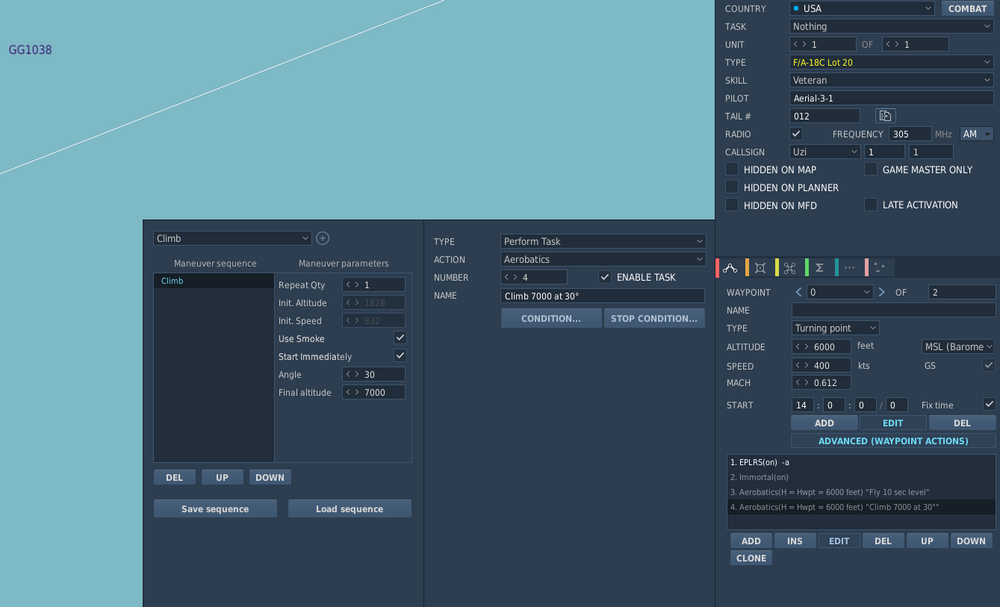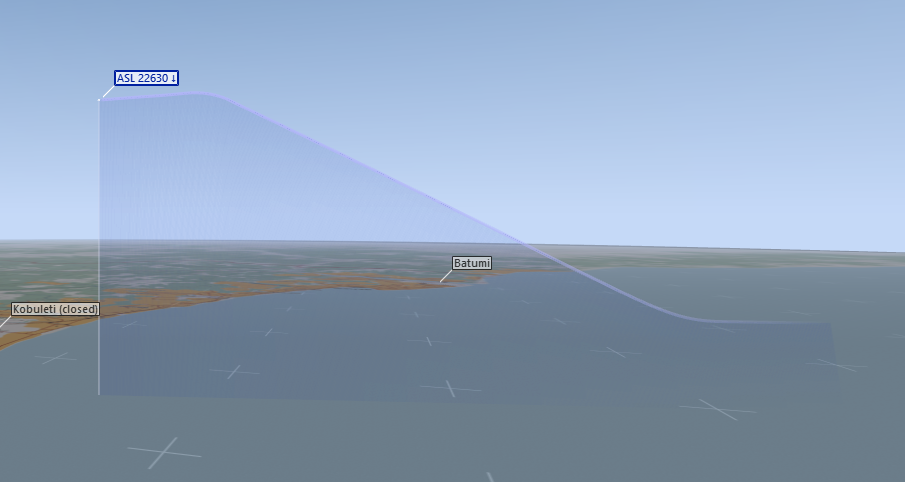-
Posts
18 -
Joined
-
Last visited
About zetikka
- Birthday March 1
Personal Information
-
Flight Simulators
DCS, MSFS
-
Location
Switzerland
-
Interests
Guess what...
-
Thanks Vakarian and NineLine, just did the testing and indeed both CLIMB and DIVE target exit altitudes in meters, event though the ME is set to Imperial units. Is this a (minor) discrepancy you guys at ED have in the to-fix list? Now I know this is not a feature-wishes section, but since aerobatics are not a hot topic... I would love to see options "figure entry time" and "figure exit time" so we can set how fast the AI aircraft enters/exits say a 45° bank turn (now it it pretty dynamic). Basically this part of aerobatics is a good playground to train formation flying with an AI leader. Thanks!
-
Tested on DCS 2.9.3.51704, Hornet module, Caucasus map. Not a recent behaviour AFAIK (noticed +6 month ago when first trying). Issue: when aerobatic task CLIMB is selected the aircraft will not stop its climb and level flight at the set Final Altitude, but generally at a random one above 20'000. Similar issue with the DIVE task BtW (will open dedicated topic for it) Attaching DCS and TacView tracks.null BUG_aerobatics_CLIMB-does_not_stop_at_set_altitude -6kto7k_6k-7k.trk BUG_aerobatics_CLIMB-does_not_stop_at_set_altitude -6kto7k.zip.acmi
-
I can only guess here... Each headset is a different combination of micro-screens and optical lenses specific to the maker, so depending on the product you can have is one case a small (pixel-count wise) screen paired with a strong set of lenses to present you with the same FoV as a higher pixel-count screen paired with a less powerfull set of lenses would do. As DCS only cares about the pixels the result would look different to your eye. And then you have the vendor with small screens who wants to sell you a huge FoV and uses huge lenses, and you get a 55' VGA display... (edited for typos)
-
What you describe really looks like the IDP physical setting of your Crystal that need to be set for you - in both of mine (Reverb G2, Quest 3) the only real impact of changing them is the comfort when looking at the cockpit instruments. Nothing wrong on the DCS side on that one I would say
-
OK, let's do some math (mind?) to stop with this "just fix your IDP" thing. If you have say a 61mm IDP and stare at an object distant 2000m away, each of your eyes will have to divert by 0.0008737° inward. It is simple trigonometry. If you have the perception that such object is like 500m away, it means the angle is 0.003495°. Four times larger. For that object to look again like it is 2000m away, I will have to reduce your IDP by the same 4x factor, so and IDP of 15.25mm. Second example: with 60mm IDP that 2000m distant object will have your eye diverting by 0.0008594°. If you increase IDP to 65mm it will look 2166m away. Can you tell +166m at 2km? I cannot. This is why changing IDP between normal values as a visible effect of the cockpit (which is a very close object), but about zero on distant ones. Can we stop beating this horse now?
-
In my opinion the perception of speed if off as a consequence of the world scale being off, so let's focus on that one only. You get the feeling of scale based on the way each image perspective is built, how parallax between the two VR images is constructed, the scale of objects you see, and what atmospheric effects you add. In DCS objects - namely trees - are notoriously off-scale and are auto-grown with distance to really ridiculous sizes to save on polygon count. That would be the main point to fix through an optional slider. It that would not be enough then other parameters should be consider, but object scale is most likely the issue.
-
For the same reason you want a faithful flight model, realistic damages, etc.: because this is supposed to be a simulation of real combat jet, not an arcade game. You do not need to agree with me, you have your expectations, I have mine. I am just sharing them and looking for possible technical solutions with whoever might be interested in reaching the same results. This in not a "I am right you are wrong" contest, let's try to be a bit more constructive than that please.
-
Your brains does that free for you, provided you have some real-life experience. I my case I have quite some hours of flying - sure not in a hornet - but hanging 1000m above an alpine valley's floor builds a good picture of what perspective/scale from is up there looks like.
-
I share your pain... also using VoiceAttack as main VR interface, but gets a bit messy when you fly multiplayer and add SRS, and possibly Discord voice as well to the mix.
-
Maybe in theory, but in practice you do not see a difference. I have tested in-cockpit yesterday, with very different IDP settings.
-
I guess one gets used to these things - I actually hardly notice anymore when I fly DCS on a regular base. It is when I do some casual MSFS VR flying in the Alps and then get back at DCS that is jumps back at me. I hope that as graphic capabilities improve ED will give up on that auto-scaling trees.
-
I know you can change IDP in the VR tab - which has only and effect on the relative size of the cockpit, but not the world around. Worldscale in the System tab is basically the zoom level in 2D mode, it has no effect on VR. None of these is specific to the F/A-18 Module though. Are you referring to some module-specific .lua file? I am definitely interest if so
-
As I understand it the issue in more on the ED side than on Helios'. The only way to get Viewports exported in VR is to check that "use system resolution" box in the VR tab (quoting from the top of my head), which will re-copy the VR view to all your physical monitors, including the one you use for Helios. I have added masking areas (actually black polygons) to my Helios template to hide most of the background image, but for some reason ED does not include an opaque background to the UFC, IFEI (radio) and RWR ViewPorts - while it does for the MFDs: So I am as stuck on it until ED changes that...
-
I think my statement lacked accuracy and was misleading: When mentioning the need for several focal planes, I was thinking about player who have physical center panels with MDF placeholders (like Winwing Phoenix), not my personal setup which is based on a single touchscreen and Helios. In my case there is no possible way I could match in the depth space my single-plane touchscreen with virtual MFDs, which are at different distances and angles. The case of the physical panel is different, since you want all of the panel visible in passthrough video, excepted for the surfaces of the three MFD plus the UFC display and radio 7-digits, which happen to be at different depths of each other from the VR PoV. If you have been using Openkneeboard in VR you know that you can set the board at any depth and angle from your PoV you want. Since that board is our chroma compositing plane for video passthrough, if you "stick" it to the plane of your MFD and cut out a piece (alpha channel =0) just the apparent size of the MFD then you really have a passthrough view of you physical panel with an aligned "from VR" MFD display. You can already do that for just one MFD (well... actually two, if you set it for right and left MFD) since Openkneeboard allows you to use a single board (compositing window, for us). If it would allow to use 3-4 boards simultaneously, each placed at an individual depth/angle in 3D space corresponding to a "to retain VR element" plane, then - ideally - you would end up seeing the whole of your physical panel with just the from-VR display inserter at the right places. Now this is *theory*, because it would require that the physical panel's distance to your headset cameras, depth deltas between elements (think UFC and MFDs) and angular size do match what ED has modeled in the Hornet's VR cockpit. I am not betting a lot of money on that when I compare my physical cockpit stick/hotas/dudder position to the in-game VR ones... Bottom line: I guess we will probably get better resolution passthrough VR headsets before ED implements the option to position in the VR space actual viewports
-
This might be a side subject by itself, but un VR DCS not only suffers from the same "slow flying" feeling as in 2D, but it adds an "off-scale" one. I have been flying both DCS and MSFS in VR, mostly over the Alps, and the feeling is like night & day: in MSFS you feel that you are up there high in the sky; in DCS you feel... like you are a 500m-tall giant walking across the hill of a scale model of the terrain. I call it "the Teletubby syndrom". You basically have a similar scale-model feeling when using the VR version of GoogleEarth. VR FoV is similar in both MSFS and DCS so I do not think that is it. Might be a mix of the way DCS calculates perspectives and how objects get automatically upscaled with the distance in DCS to save on polygons. A 20m-tall tree that auto-grows to 200m in the distance sure looks weird, but your brain can pick up large objects in the distance and still tell they are tall. I think it has to be the way DCS deals with perspective in VR, maybe IPD calculation is off when it comes to the external world (since that is our natural rangefinder).




